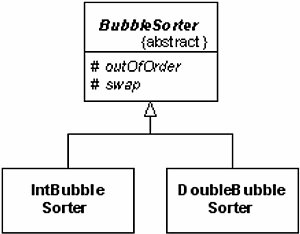Template Method
| Consider all the programs you have written. Many probably have this fundamental main loop structure: Initialize(); while (!Done()) // main loop { Idle(); // do something useful. } Cleanup();First, we initialize the application. Then we enter the main loop, where we do whatever the program needs to do. We might process GUI events or perhaps database records. Finally, once we are done, we exit the main loop and clean up before we exit. This structure is so common that we can capture it in a class named Application. Then we can reuse that class for every new program we want to write. Think of it! We never have to write that loop again![2]
For example, consider Listing 22-1. Here, we see all the elements of the standard program. The Textreader and TextWriter are initialized. A Main loop reads Fahrenheit readings from the Console.In and prints out Celsius conversions. At the end, an exit message is printed. Listing 22-1. FtoCRaw.cs
This program has all the elements of the preceding main loop structure. It does a little initialization, does its work in a Main loop, and then cleans up and exits. We can separate this fundamental structure from the ftoc program by using the TEMPLATE METHOD pattern. This pattern places all the generic code into an implemented method of an abstract base class. The implemented method captures the generic algorithm but defers all details to abstract methods of the base class. So, for example, we can capture the main loop structure in an abstract base class called Application. See Listing 22-2. Listing 22-2. Application.cs
This class describes a generic main-loop application. We can see the main loop in the implemented Run function. We can also see that all the work is being deferred to the abstract methods Init, Idle, and Cleanup. The Init method takes care of any initialization we need done. The Idle method does the main work of the program and will be called repeatedly until SetDone is called. The Cleanup method does whatever needs to be done before we exit. We can rewrite the ftoc class by inheriting from Application and simply filling in the abstract methods. Listing 22-3 show what this looks like. Listing 22-3. FtoCTemplateMethod.cs
It's easy to see how the old ftoc application has been fit into the TEMPLATE METHOD pattern. Pattern AbuseBy this time, you should be thinking "Is he serious? Does he really expect me to use this Application class for all new apps? It hasn't bought me anything, and it's overcomplicated the problem." Er..., Yeah.. :^( I chose the example because it was simple and provided a good platform for showing the mechanics of TEMPLATE METHOD. On the other hand, I don't really recommend building ftoc like this. This is a good example of pattern abuse. Using TEMPLATE METHOD for this particular application is ridiculous. It complicates the program and makes it bigger. Encapsulating the main loop of every application in the universe sounded wonderful when we started, but the practical application is fruitless in this case. Design patterns are wonderful things. They can help you with many design problems. But the fact that they exist does not mean that they should always be used. In this case, TEMPLATE METHOD was applicable to the problem, but its use was not advisable. The cost of the pattern was higher than the benefit it yielded. Bubble SortSo let's look at a slightly more useful example. See Listing 22-4. Note that like Application, Bubble Sort is easy to understand, and so makes a useful teaching tool. However, no one in their right mind would ever use Bubble Sort if they had any significant amount of sorting to do. There are much better algorithms. Listing 22-4. BubbleSorter.cs
The BubbleSorter class knows how to sort an array of integers, using the bubble sort algorithm. The Sort method of BubbleSorter contains the algorithm that knows how to do a bubble sort. The two ancillary methodsSwap and CompareAndSwapdeal with the details of integers and arrays and handle the mechanics that the Sort algorithm requires. Using the TEMPLATE METHOD pattern, we can separate the bubble sort algorithm out into an abstract base class named BubbleSorter.BubbleSorter contains a Sort function implementation that calls an abstract method named OutOfOrder and another called Swap. The OutOfOrder method compares two adjacent elements in the array and returns true if the elements are out of order. The Swap method swaps two adjacent cells in the array. The Sort method does not know about the array; nor does it care what kinds of objects are stored in the array. It simply calls OutOfOrder for various indices into the array and determines whether those indices should be swapped. See Listing 22-5. Listing 22-5. BubbleSorter.cs
Given BubbleSorter, we can now create simple derivatives that can sort any different kind of object. For example, we could create IntBubbleSorter, which sorts arrays of integers, and DoubleBubbleSorter, which sorts arrays of doubles. See Figure 22-1 and Listings 22-6, and 22-7. Figure 22-1. Bubble sorter structure The TEMPLATE METHOD pattern shows one of the classic forms of reuse in object-oriented programming. Generic algorithms are placed in the base class and inherited into different detailed contexts. But this technique is not without its costs. Inheritance is a very strong relationship. Derivatives are inextricably bound to their base classes. Listing 22-6. IntBubbleSorter.cs
Listing 22-7. DoubleBubbleSorter.cs
For example, the OutOfOrder and Swap functions of IntBubbleSorter are exactly what are needed for other kinds of sort algorithms. But there is no way to reuse OutOfOrder and Swap in those other sort algorithms. By inheriting BubbleSorter, we have doomed IntBubbleSorter to be forever bound to BubbleSorter. The STRATEGY pattern provides another option. |
EAN: 2147483647
Pages: 272

